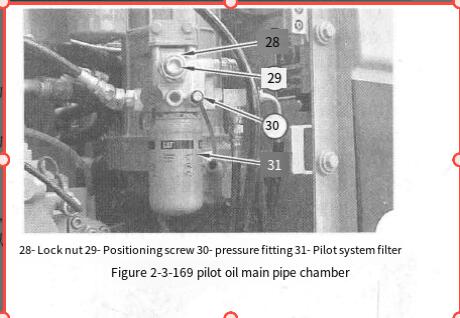
The pilot relief valve on a Caterpillar 320C excavator is a critical component that regulates the hydraulic pressure in the system. It ensures that the pressure does not exceed safe limits, preventing damage to the machine. Regular testing and adjustment of the pilot relief valve is essential to maintain optimal performance. Here is a step-by-step guide on how to test and adjust the pilot relief valve on a Caterpillar 320C excavator:
1. Park the machine on flat ground to ensure stability during the testing and adjustment process.
2. Turn off the engine to eliminate any potential hazards and allow for a safe working environment.
3. Release the pressure of the hydraulic system by following the instructions in the “Pressure Relief of the Hydraulic System” section of the excavator’s manual.
4. Connect a 6000kPa pressure gauge to the pressure measuring joint 30, as shown in Figure 2-3-169. This will allow you to accurately measure the pressure during the testing and adjustment process.
5. Start the engine to provide power to the hydraulic system.
6. Set the machine control volume as specified in the manual. The engine tachometer should be set to 10, and the AEC (Automatic Engine Control) switch should be set to OFF. Refer to the “Engine Performance Testing” section of the manual for the recommended engine RPM settings.
7. Increase the hydraulic oil temperature to a level between 55 ± 5 degrees Celsius. This temperature range ensures optimal performance of the hydraulic system during the testing and adjustment process.
8. Check the setting of the pilot safety valve at pressure measuring joint 30. The pilot safety valve should be set at (4100 ± 200) kPa. If the setting is not within specifications, it will need to be adjusted.

9. To adjust the pilot relief valve, start by loosening the locknut 28. This will allow you to access the set screw 29.
10. Rotate the set screw 29 until the pressure gauge connected to the pressure test joint 30 reads (4100 ± 200) kPa. It is important to note that turning the set screw clockwise will increase the pressure, while turning it counterclockwise will decrease the pressure. Always make final pressure adjustments as pressure increases.
11. Once the desired pressure is achieved, tighten the locknut 28 to a torque of (49 ± 4.9) N.m. This ensures that the adjustment remains in place and prevents any unintended changes.
12. It is crucial to ensure that the engine and pump are running properly while making pressure adjustments. If the pressure adjustment is not correct, it is recommended to check the characteristic curves of the engine and pump to identify any underlying issues.
By following these steps, you can effectively test and adjust the pilot relief valve on your Caterpillar 320C excavator. Regular maintenance and inspection of this valve will help prolong the lifespan of your machine and ensure safe and efficient operation.
More repair cases for Caterpillar engine,please refer to: Caterpillar Trouble Repair
Leave a Reply